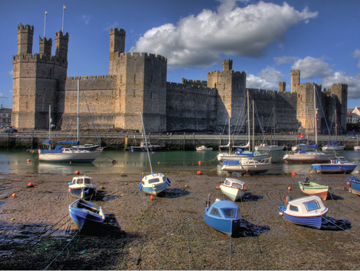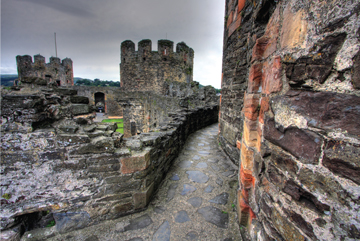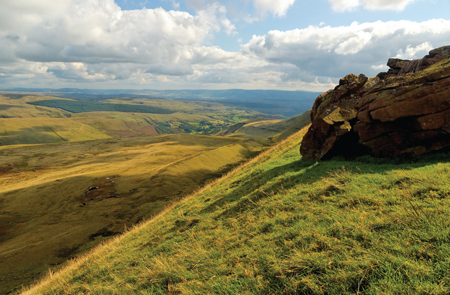Dylan Thomas wrote poetry in an 1845 house named Seaview for its perch above the estuary in Laugharne, Wales. Walking to the beach from the house—now a small inn—I could see why the celebrated Welsh poet chose to live here. As he wrote in Quite Early One Morning, three rivers and a “visiting sea” grace the “timeless, beguiling island of a town.”
For the rest of the week I spent in Wales with my wife last summer, driving and hiking its wriggling coastline and the stone-pocked mountains of Snowdonia, I would learn whether timeless and beguiling also described the rest of Wales. I already knew that less poetic adjectives like accessible and affordable fit. Wales is far less expensive to visit than London, yet only two hours away. It feels more foreign than anywhere in the British Isles, and it teems with scenic and historic sights in an area the size of New Jersey. They even speak English, except for the small minority who speak only Welsh.
Cardiff is a straight shot by highway from London. It’s Wales’s largest city (pop. 305,000), but small enough to be appreciated in a day. The magnet for visitors is Cardiff Castle, a Roman-era fortress so expansive that a village once flourished inside its walls, and with long, dark corridors that centuries later provided shelter from World War II air raids. From the castle keep we could see beyond the time-weathered pubs of the city to Cardiff Bay’s ultramodern Millennium Center, the country’s iconic opera house.
 If we wanted culture, however, we’d have stayed in London. In the morning we drove west into Pembrokeshire Coast National Park until the road ended at the village of St. David’s. Like the Marin Headlands, St. David’s Head meets the sea in dramatic fashion with soaring bluffs of rock, soil and grass. The Coast Path, which clings to southwest Wales’s bluffs for 186 miles, zigged where I expected a zag, so our planned short hike became a long trek. Fortunately, we were fueled by fresh Welsh cakes, a cross between biscuits and shortbread cookies, that we’d purchased at a roadside store. While we hiked, weekenders flew kites from the sheep pastures above and “coasteered” from the cliffs below. Coasteering is a Welsh invention that combines rock climbing, cliff jumping and ocean swimming in wetsuits and helmets. That was an early clue for understanding the Welsh personality: they take pride in their quirks. As a waitress told us that night, after explaining that “jacket potatoes” is the Welsh term for unpeeled baked potatoes, “We like to be different.”
If we wanted culture, however, we’d have stayed in London. In the morning we drove west into Pembrokeshire Coast National Park until the road ended at the village of St. David’s. Like the Marin Headlands, St. David’s Head meets the sea in dramatic fashion with soaring bluffs of rock, soil and grass. The Coast Path, which clings to southwest Wales’s bluffs for 186 miles, zigged where I expected a zag, so our planned short hike became a long trek. Fortunately, we were fueled by fresh Welsh cakes, a cross between biscuits and shortbread cookies, that we’d purchased at a roadside store. While we hiked, weekenders flew kites from the sheep pastures above and “coasteered” from the cliffs below. Coasteering is a Welsh invention that combines rock climbing, cliff jumping and ocean swimming in wetsuits and helmets. That was an early clue for understanding the Welsh personality: they take pride in their quirks. As a waitress told us that night, after explaining that “jacket potatoes” is the Welsh term for unpeeled baked potatoes, “We like to be different.”
Dylan Thomas was certainly that, I learned the next morning after walking to the Dylan Thomas Boathouse, where the poet lived and wrote in his final years. Now a museum, it’s as understated and uncrowded as Laugharne’s nearby castle and beach. Thomas was drinking and in debt most of the time he lived in Laugharne, and accordingly scorned by most locals. No doubt he would have taken wry pleasure in the townsfolk’s eventual decision to honor him, much as Salinas was slow to honor John Steinbeck.
It was time to venture inland for a midday chat with Gordon Green, 74, in the sheep country village of Llanwrtyd Wells, the world capital of weird sports. (It would be Llantweird Wells if vowels were more welcome in Welsh, a musical language to hear spoken or sung, but impossible for outsiders to pronounce.) In his hotel’s cozy pub we found Green, founder of the eponymously named Green Events, which include the Man vs. Horse Marathon (once won by Marin mountain bike pioneers Roy Rivers and Jacquie Phelan), a bog snorkeling race (snorkeling though four feet of mud), and a mountain-bike bog snorkeling race (mountain biking in six feet of mud). “Most involve some combination of athletics and drinking,” Green said with a chuckle, “and they’ve drawn thousands of people for 30 years.”
As we left the village, the hills grew higher and pasture yielded to forest. We stopped for a one-hour walk beneath Devil’s Bridge (actually three bridges stacked atop one another above tiered waterfalls). We strolled the beach promenade in Aberystwyth between the town castle and a funicular railway that provides views all the way to Ireland. B&Bs advertised rates as low as $45, affirming Wales’s ranking as Western Europe’s fourth most affordable country for travel. At dusk we reached our inn in the coastal town of Aberdovey, where the slab of plaice (a North Sea fish) I ordered was so huge it drooped over both sides of the plate.
 The next morning we toured the Centre for Alternative Technology in Machynlleth, Europe’s oldest and largest center for research on sustainability and climate change. A hydro-powered tram rises from the parking lot to the forested grounds, and visitors stay engaged with countless interactive displays. We saw a demonstration house insulated by sheep’s wool (purportedly the best of all insulating materials), learned how an electric car works and walked through an organic garden. The center also offers a three-day renewable energy course and accommodations in a cabin powered by on-site solar and wind energy.
The next morning we toured the Centre for Alternative Technology in Machynlleth, Europe’s oldest and largest center for research on sustainability and climate change. A hydro-powered tram rises from the parking lot to the forested grounds, and visitors stay engaged with countless interactive displays. We saw a demonstration house insulated by sheep’s wool (purportedly the best of all insulating materials), learned how an electric car works and walked through an organic garden. The center also offers a three-day renewable energy course and accommodations in a cabin powered by on-site solar and wind energy.
Afterward, we pointed our VW Golf toward Snowdonia National Park. The park’s highest peak, Snowdon, rises to only 3,560 feet, but the steep, rocky slopes, mostly barren of trees, give these mountains a stark, ethereal beauty that draws hikers from throughout Britain. Centuries-old slate walls built by shepherds, twig-like waterfalls and cliff-clinging hiking trails cleave the slopes like the veins of leaves.
We spent our last day inside several castles on the country’s north coast. Some say that Caernarfon and Conwy castles, both UNESCO World Heritage Sites, are the world’s finest medieval castles. Both castles and the surrounding walled towns that share their names are in such good shape they might just last another millennium or two. Caernarfon was memorable for the many stone stairways and levels to explore, Conwy for its turret views of the bridges that cross the River Conwy. We even squeezed in a third castle that day—Penrhyn, a bizarre but opulent neo-Norman mock castle.
By the time we left Wales, timeless and beguiling for us only began to describe the place. Captivating may be the best adjective, because I resolved, as Dylan Thomas so famously wrote, to not “go gentle into that good night” before returning for another visit.
If You Go
Travel in Wales: travelwales.org
City of Cardiff: visitcardiff.com
Dylan Thomas Boathouse Museum: dylanthomasboathouse.com
Seaview Inn: seaview-laugharne.co.uk
Green Events: green-events.co.uk
Centre for Alternative Technology: cat.org.uk
Wales castles: castlewales.com


